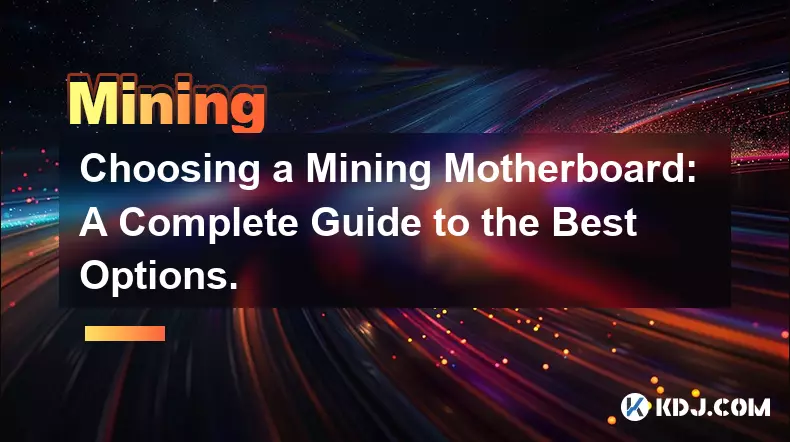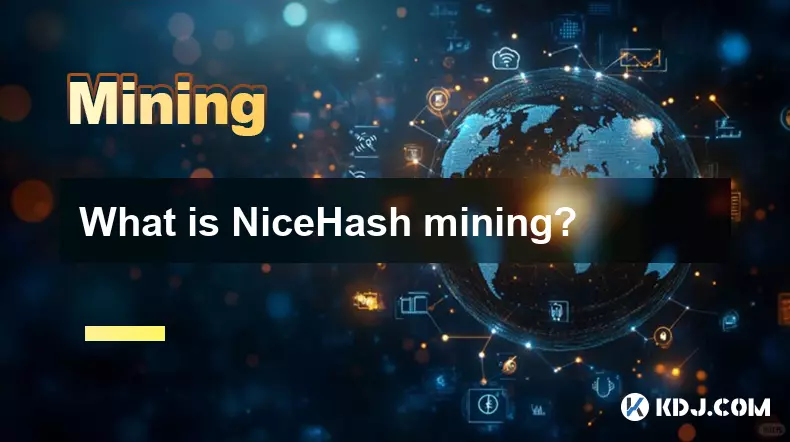-
 bitcoin
bitcoin $100977.009184 USD
-2.05% -
 ethereum
ethereum $3282.009150 USD
-3.23% -
 tether
tether $0.999813 USD
-0.02% -
 xrp
xrp $2.208254 USD
-4.89% -
 bnb
bnb $951.411089 USD
0.55% -
 solana
solana $155.761205 USD
-2.84% -
 usd-coin
usd-coin $1.000217 USD
0.02% -
 tron
tron $0.284475 USD
-1.28% -
 dogecoin
dogecoin $0.162363 USD
-1.53% -
 cardano
cardano $0.533988 USD
-0.47% -
 hyperliquid
hyperliquid $39.174339 USD
-3.22% -
 chainlink
chainlink $14.724828 USD
-1.16% -
 bitcoin-cash
bitcoin-cash $477.297986 USD
-1.28% -
 zcash
zcash $554.227426 USD
17.30% -
 ethena-usde
ethena-usde $0.998995 USD
-0.03%
Choosing a Mining Motherboard: A Complete Guide to the Best Options.
A mining motherboard is the backbone of a crypto rig, designed to support multiple GPUs via PCIe slots, ensure 24/7 stability, and maximize hash rates efficiently.
Nov 05, 2025 at 09:00 am

Understanding Mining Motherboards and Their Role in Cryptocurrency
1. A mining motherboard serves as the central hub for all components in a cryptocurrency mining rig, connecting GPUs, power supplies, and storage devices. Unlike standard motherboards used in regular PCs, mining motherboards are optimized to support multiple graphics cards simultaneously. This capability is crucial because GPU-based mining relies heavily on parallel processing power.
2. The choice of motherboard directly impacts mining efficiency, stability, and scalability. Boards designed for mining typically feature multiple PCIe slots, allowing users to install six or more GPUs on a single system. These slots must be properly spaced and reinforced to handle the weight and power demands of high-end graphics cards.
3. Compatibility with various processors and memory types also plays a significant role. Most mining rigs use low-cost CPUs since computational work is handled by the GPUs. However, the motherboard must still support a functional CPU and sufficient RAM to run the mining operating system smoothly.
4. Reliability under continuous operation is another key factor. Mining rigs often run 24/7, placing constant stress on components. High-quality capacitors, robust voltage regulation modules (VRMs), and effective BIOS support help ensure long-term performance without frequent crashes or hardware failures.
5. Some mining motherboards come with specialized features such as PCIe riser connectors built into the board, onboard voltage test points, and dual BIOS options for recovery. These enhancements reduce wiring complexity and improve troubleshooting capabilities during extended mining operations.
Top Features to Look for in a Mining Motherboard
1. Number of PCIe Slots: The primary consideration when selecting a mining motherboard is the number of available PCIe x16 slots. More slots mean more GPUs can be connected, increasing hash rate potential. Boards like the ASUS B250 MINING EXPERT offer up to 19 PCIe slots, making them ideal for large-scale setups.
2. BIOS Support and Stability: A reliable BIOS ensures that all connected GPUs are recognized and function correctly. Regular BIOS updates from manufacturers can fix compatibility issues with new GPU models and improve overall system stability during prolonged use.
3. Power Delivery and Efficiency: Efficient power delivery reduces energy waste and heat generation. Mining motherboards should have durable power phases and high-quality chokes to maintain consistent performance even when multiple GPUs draw heavy loads from the system.
4. Form Factor and Build Quality: Extended ATX or custom form factors provide better layout options for multi-GPU configurations. Reinforced slot brackets prevent sagging and physical damage to both the motherboard and GPUs over time.
5. Compatibility with Mining OS and Software: Many miners use lightweight Linux-based operating systems such as HiveOS or SimpleMining OS. The motherboard must support booting from USB drives and have compatible drivers for network and storage interfaces used in these environments.
Popular Mining Motherboard Models and Their Specifications
1. ASUS B250 MINING EXPERT: Designed specifically for cryptocurrency mining, this board supports up to 19 GPUs via PCIe x1 slots expanded through M.2 adapters. It includes dedicated monitoring tools, surge protection, and an auto-restart feature after power outages.
2. MSI H310-F PRO: A budget-friendly option supporting up to seven GPUs. While it lacks the extreme expansion of higher-end models, its solid build quality and compatibility with 8th and 9th Gen Intel processors make it suitable for mid-sized mining farms.
3. Gigabyte GA-H110-D3A: Known for durability, this model provides nine PCIe slots and supports older LGA1151 CPUs. Its legacy BIOS interface may require manual tuning but offers excellent value for miners using cost-effective hardware combinations.
4. Biostar TB250-BTC PRO: One of the early dedicated mining boards, supporting up to eight GPUs. It features dual BIOS, PCI-e bifurcation support, and a compact design ideal for space-constrained mining racks.
5. ASRock H110 Pro BTC+: Famous for enabling six-GPU setups, this board was widely adopted during the 2017 mining boom. Though older, it remains functional with modern mining software and continues to be supported by community-driven firmware updates.
Frequently Asked Questions
What is PCIe bifurcation, and why is it important for mining?PCIe bifurcation allows a single PCIe slot to split its lanes into multiple connections, enabling the use of riser cables to attach several GPUs to one physical slot. This feature is essential on motherboards with limited physical slots but high GPU expansion needs.
Can I use a regular desktop motherboard for mining?Yes, but with limitations. Standard motherboards usually support only two or three GPUs due to space and bandwidth constraints. They lack optimizations like reinforced slots and surge protection found in mining-specific boards, leading to reduced reliability over time.
Do mining motherboards support NVMe SSDs?Most do. NVMe support allows faster boot times and smoother operation when running mining OS from a solid-state drive. Check the specific model’s specifications to confirm M.2 NVMe compatibility before purchase.
Is overclocking possible on mining motherboards?Overclocking the CPU is generally unnecessary since mining relies on GPU performance. Some boards allow limited memory or PCIe frequency adjustments, but stability takes priority over performance gains in most mining scenarios.
Disclaimer:info@kdj.com
The information provided is not trading advice. kdj.com does not assume any responsibility for any investments made based on the information provided in this article. Cryptocurrencies are highly volatile and it is highly recommended that you invest with caution after thorough research!
If you believe that the content used on this website infringes your copyright, please contact us immediately (info@kdj.com) and we will delete it promptly.
- BlockDAG, Avalanche, Dogecoin: Crypto's Leading Trio in 2025
- 2025-11-07 22:05:01
- Layer 2 Coins: Will There Be a Potential Explosion by 2026?
- 2025-11-07 16:50:02
- Filecoin, ICP, and the AI Infrastructure Renaissance: Is History Repeating?
- 2025-11-07 16:50:02
- Bitcoin's Wild Ride: Surges, Zeros, and the Search for Stability
- 2025-11-07 17:05:01
- XRP, Bitcoin, and the Rally: What's the Deal, New York?
- 2025-11-07 17:25:01
- Filecoin, DePIN, and a Technical Breakout: What's the Buzz?
- 2025-11-07 17:05:01
Related knowledge

What is the block reward in mining?
Nov 06,2025 at 12:35am
Understanding Block Rewards in Cryptocurrency Mining1. The block reward is the incentive miners receive for successfully validating and adding a new b...

How do mining algorithms work?
Nov 06,2025 at 04:59am
Mining Algorithms and Their Role in Blockchain Networks1. Mining algorithms serve as the backbone of blockchain consensus mechanisms, ensuring that tr...

What is NiceHash mining?
Nov 06,2025 at 07:40am
NiceHash mining refers to the process of renting out computational power to individuals or organizations seeking to mine cryptocurrencies without owni...

Does an antivirus program affect mining?
Nov 05,2025 at 09:29pm
Understanding Decentralized Exchanges in the Crypto Ecosystem1. Decentralized exchanges (DEXs) operate without a central authority, allowing users to ...

What is the history of Bitcoin mining?
Nov 05,2025 at 08:15pm
Within the fast-moving world of cryptocurrency, new developments emerge daily, reshaping how investors, developers, and institutions interact with dig...

How is the energy consumption of mining justified?
Nov 05,2025 at 10:20pm
Energy Consumption in Cryptocurrency Mining1. The energy consumption associated with cryptocurrency mining has drawn significant attention from enviro...

What is the block reward in mining?
Nov 06,2025 at 12:35am
Understanding Block Rewards in Cryptocurrency Mining1. The block reward is the incentive miners receive for successfully validating and adding a new b...

How do mining algorithms work?
Nov 06,2025 at 04:59am
Mining Algorithms and Their Role in Blockchain Networks1. Mining algorithms serve as the backbone of blockchain consensus mechanisms, ensuring that tr...

What is NiceHash mining?
Nov 06,2025 at 07:40am
NiceHash mining refers to the process of renting out computational power to individuals or organizations seeking to mine cryptocurrencies without owni...

Does an antivirus program affect mining?
Nov 05,2025 at 09:29pm
Understanding Decentralized Exchanges in the Crypto Ecosystem1. Decentralized exchanges (DEXs) operate without a central authority, allowing users to ...

What is the history of Bitcoin mining?
Nov 05,2025 at 08:15pm
Within the fast-moving world of cryptocurrency, new developments emerge daily, reshaping how investors, developers, and institutions interact with dig...

How is the energy consumption of mining justified?
Nov 05,2025 at 10:20pm
Energy Consumption in Cryptocurrency Mining1. The energy consumption associated with cryptocurrency mining has drawn significant attention from enviro...
See all articles





















![The Graph Price Prediction [GRT Crypto Price News Today] The Graph Price Prediction [GRT Crypto Price News Today]](/uploads/2025/11/07/cryptocurrencies-news/videos/690d4df44fe69_image_500_375.webp)




















































